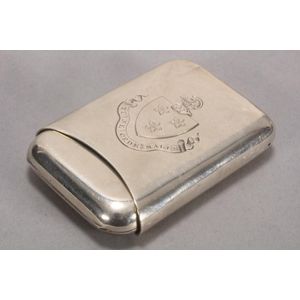Victorian Sterling Silver Cigarette Case, London 1878, Provenance Collection
Victorian sterling silver cigarette case, hallmarked London, 1878, Ehs (Edward H Stockwell), of rectangular form, decorated with heraldic motif to cover and inscribed 'Tu Ne Cede Malis', sliding out to reveal reeded hinged case, with gilt interior with inscriptions, total weight 103gm, 9 cm x 6 cm. Provenance: collection of the late Fredric Sinfield, Sydney NSW, 1938 - 2008
You must be a subscriber, and be logged in to view price and dealer details.
Subscribe Now to view actual auction price for this item
When you subscribe, you have the option of setting the currency in which to display prices to $Au, $US, $NZ or Stg.
This item has been sold, and the description, image and price are for reference purposes only.
- Sterling Silver - Sterling silver is a mixture of 92.5% pure silver and 7.5% of another metal, usually copper. Fine silver is 99.9% pure silver, and is relatively soft and the addition of the very small amount of copper gives the metal enough strength and hardness to be worked into jewellery, decorative and household objects.
- Victorian Period - The Victorian period of furniture and decorative arts design covers the reign of Queen Victoria from 1837 to 1901. There was not one dominant style of furniture in the Victorian period. Designers used and modified many historical styles such as Gothic, Tudor, Elizabethan, English Rococo, Neoclassical and others, although use of some styles, such as English Rococo and Gothic tended to dominate the furniture manufacture of the period.
The Victorian period was preceded by the Regency and William IV periods, and followed by the Edwardian period, named for Edward VII (1841 ? 1910) who was King of the United Kingdom and the British Dominions and Emperor of India for the brief period from 1901 until his death in 1910. - Heraldic Decoration - Heraldic decoration on silver, glass, and porcelain refers to the use of coats of arms and other heraldic symbols as decorative motifs on these materials. Coats of arms were traditionally used to identify individuals, families, and institutions, and were often displayed on shields, banners, and other objects.
The heraldic decoration typically takes the form of engraved or etched designs that incorporate coats of arms or other heraldic symbols. Heraldic decoration on silver, glass, and porcelain has a long history, dating back to the medieval period when coats of arms were first used. During the Renaissance and Baroque periods, heraldic decoration on decorative objects became increasingly elaborate and ornate, with finely detailed designs that often incorporated intricate scrollwork, mythological figures, and other decorative motifs.
In the 18th and 19th centuries, heraldic decoration became particularly popular among the aristocracy and upper classes, who used these objects as symbols of their wealth and status.
This item has been included into following indexes:
